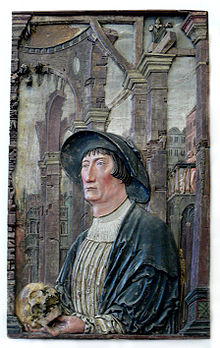Hans Schenck


Hans Schenck , also called Hans Scheußlich, Scheutzlich, Latin Pincerna (= cupbearer) (* around 1500 in Schneeberg , † around 1566 in Berlin ) was a German sculptor and medalist .
Life
He is the son of the father of the same name, Hans Schenck the old, who had already exchanged the ugly family name Schenck for Schenck. It is believed that he learned how to build the St. Anne's Church in Annaberg . He left Saxony early and entered the service of the Hohenzollern . In 1526, Duke Albrecht of Prussia sent him to the Polish court because they urgently needed a skilled sculptor. After returning from Poland , he lived mainly in Berlin and was probably the first electoral court sculptor. In Berlin, he played a major role in decorating the palace . Presumably he was even the site manager. In 1543 he acquired citizenship and a house on Heiliggeiststrasse. In the middle of 1540 he probably went to the Pomeranian dukes Philip I and Barnim IX. from Pomerania . In the 1550s, his journeymen were involved in building the council chamber above the Berlin court arbor.
In the Nikolaikirche in Berlin three grave slabs bear the hallmarks of his rather bizarre, mannerist style. The epitaph for Joachim Zerer, the electoral chamber secretary who died in 1543, in the Marienkirche in Berlin is ascribed to him. This epitaph is characterized by greater simplicity, the overloading is missing here.
The Zecherrelief from the hunting lodge Grunewald , a scene with half- length figures, probably later walled in, dates from around 1537–1542 .
In addition to his achievements as a sculptor, his services as a medal cutter should also be emphasized.
Works
- 1558: Friedrich tomb in the cathedral of Halberstadt = main work
- Design of the city palace in Berlin
- Tombs in Berlin and Brandenburg
- Elements in the Grunewald hunting lodge and in the destroyed castle in Königsberg
- Salomonistor in Dresden (attributed)
- Stone epitaph for Thomas Matthias
- Portrait panel of Duke Barnims IX. / XI. and Anna von Braunschweig-Lüneburg 1545, limestone (Muzeum Narodowe w Szczecinie)
- Foundation plaque of Ueckermünde Castle with the portrait of Duke Philip I , 1546 (Muzeum Narodowe w Szczecinie)
literature
- Hans Joachim Seeger: Hans Schenck (called hideous). Dissertation Leipzig 1930.
- Andreas Cante: The sculptor and medalist Hans Schenck or Scheusslich. A Renaissance artist during the Reformation . Dissertation FU Berlin 2004 (2007).
- Andreas Cante: painter and sculptor at the court of Electors Joachim I and Joachim II in the mirror of the sources . In: Foundation Prussian Palaces and Gardens Berlin-Brandenburg (ed.): Cranach and the art of the Renaissance under the Hohenzollern: Church, court and urban culture. Deutscher Kunstverlag, Munich / Berlin 2009, ISBN 978-3-422-06910-7 , pp. 48–53.
Individual evidence
- ↑ DI 75, Halberstadt Dom, No. 201 (Hans Fuhrmann), in: www.inschriften.net, urn: nbn: de: 0238-di075l003k0020106 .
Web links
| personal data | |
|---|---|
| SURNAME | Schenck, Hans |
| ALTERNATIVE NAMES | Schenk, Hans; Terrible, Hans; Terrible, Hans; Pincerna (Latin) |
| BRIEF DESCRIPTION | German sculptor and medalist |
| DATE OF BIRTH | around 1500 |
| PLACE OF BIRTH | Schneeberg |
| DATE OF DEATH | around 1566 |
| Place of death | Berlin |
